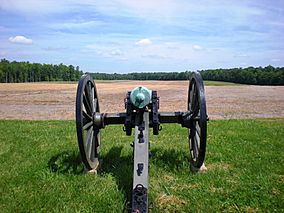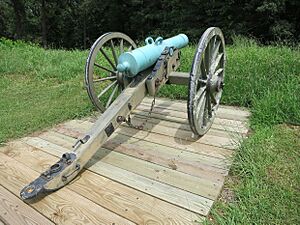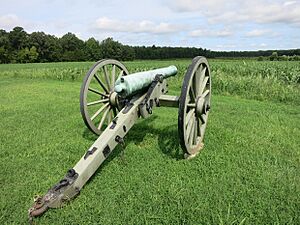Richmond National Battlefield Park facts for kids
Quick facts for kids Richmond National Battlefield Park |
|
|---|---|

Union gun position at Malvern Hill
|
|
| Location | Richmond, Hanover County, Henrico County, Chesterfield County, Virginia, USA |
| Nearest city | Richmond, Virginia |
| Area | 8,168.87 acres (33.0582 km2) |
| Established | March 2, 1936 |
| Visitors | 94,967 (in 2016) |
| Governing body | National Park Service |
| Website | Richmond National Battlefield Park |
|
Richmond National Battlefield Park
|
|
| NRHP reference No. | 66000836 |
| Significant dates | |
| Added to NRHP | October 15, 1966 |
The Richmond National Battlefield Park helps us remember 13 important places from the American Civil War. These sites are all around Richmond, Virginia, which was the capital of the Confederate States of America for most of the war. The park connects different parts of the city with old forts and battlefields nearby.
Contents
Richmond's Role in the Civil War
Virginia decided to leave the United States in May 1861. It then joined the Confederacy. Richmond was a big factory town, so it was chosen to be the Confederate capital. Many battles happened around the city over the next four years.
Richmond National Battlefield Park covers almost 3,000 acres in Virginia. It includes land near the James and Chickahominy Rivers. Much of the park looks just like it did during the Civil War. You can see beautiful meadows and old forests, which are home to lots of wildlife.
Exploring Richmond's Historic Sites
Tredegar Iron Works: A Key Factory
The Tredegar Iron Works was the most important iron factory for the Confederacy. It was a big reason why Richmond became the capital. This factory made about half of all the cannons used by the Confederate army. Today, visitors can find a museum, park rangers, and interactive displays here.
Chimborazo Hospital: A Giant Hospital
Chimborazo Hospital was the Confederacy's largest hospital camp. It could hold up to 4,000 patients at one time. Most patients came here to recover from their injuries or illnesses. The museum now shows surgical tools and medical displays, along with a film.
Famous Battles Around Richmond
The Peninsula Campaign: An Early Attack
The Peninsula Campaign was an attempt by Union General George B. McClellan to attack Richmond. He tried to move his army from the east, using the James River. Confederate cannons slowed him down, but he got within four miles of the city. However, a surprise attack by General Joseph E. Johnston stopped him.
Chickahominy Bluffs: A River Barrier
General McClellan tried to capture Richmond, but the Chickahominy River stopped him. The river was flooded, making it a strong natural defense. Parts of his army were separated by the wide waterway.
Drewry's Bluff: Forts on the River
Drewry's Bluff was a sharp bend in the James River. A Confederate fort there was too high for the Union Navy's cannons to hit. The Union ships had to turn back. This delayed McClellan's plan to advance on Richmond.
The Seven Days Battles: Lee's Big Push
The Seven Days Battles were a quick series of fights in 1862. They were started by the new Confederate commander, Robert E. Lee. General McClellan soon had to retreat. However, Lee's plan to trap the Union army did not work.
Beaver Dam Creek: A Costly Fight
This battle is also known as Mechanicsville. Lee's partner, 'Stonewall' Jackson, arrived late, which was unusual for him. The Confederates suffered many losses. Still, the Union army moved downstream to a safer spot. You can walk a trail along the lower part of the creek today.
Gaines' Mill: A Major Confederate Victory
General McClellan's defenses seemed very strong at Gaines' Mill. But Lee launched his biggest attack of the war with 57,000 soldiers. McClellan had to retreat to the James River. He gave up his plan to capture Richmond. Walking trails and signs help visitors understand the battle.
Glendale: Saving the Retreat
Lee saw a chance to cut off McClellan's army from the river at Glendale. But Union counter-attacks protected their escape route. Several Union generals were hurt, and General George A. McCall was captured. There is a visitor center here during certain times of the year.
Malvern Hill: Artillery Power
Malvern Hill was the last of the Seven Days Battles. The Union army won this battle because they had better cannons. However, their commander, McClellan, was not there. He was scouting Harrison’s Landing, where his army soon retreated. This site has a visitor center and tours.
The Overland Campaign: Grant's Advance
The Overland Campaign was Ulysses S. Grant's first campaign as the main Union general. He fought alongside the army commander, George Meade. The campaign began with a tough fight at the Battle of the Wilderness. It was followed by defeats for the Union at Spotsylvania Court House and Cold Harbor.
Totopotomoy Creek: Entrenched Defenses
At Totopotomoy Creek, Grant tried to trick Lee into fighting in open ground. But the Confederates were well-hidden behind the creek. They stopped all Union attacks. The beautiful Rural Plains mansion survived much of the fighting. You can tour the Rural Plains (Shelton House) today.
Cold Harbor: A Regrettable Attack
After some early success, Grant ordered a huge attack against Lee's strong positions at Cold Harbor. The attack was pushed back, and the Union suffered many casualties. Grant later said it was his biggest regret. This battle was Lee's last major victory. There is a visitor center and a forest trail with signs.
Siege of Petersburg: The Final Push

After his losses in the Overland Campaign, U.S. Grant began a long siege. He used his larger army to wear down Lee's tired and hungry Confederates. When Petersburg finally fell, Richmond's surrender was sure to follow soon after.
Fort Harrison: A Key Capture
Fort Harrison was a very important fort for defending Richmond. Union General Benjamin Butler captured it. This forced Lee to move his entire defense line further west. The fort was renamed Fort Burnham to honor a Union general killed in the battle. It has a visitor center open at certain times.
Howlett Line: Holding the Line
The Howlett Line was a series of earthworks, or dirt forts. They stretched across the Bermuda Hundred peninsula. A small Confederate force used these defenses to keep General Benjamin Butler's army stuck. Grant famously said it was "like a cork in a bottle."
See also
- Petersburg National Battlefield, which covers the southern parts of the Richmond-Petersburg Campaign.
- Richmond National Cemetery, located where the Battle of Seven Pines happened.
- Seven Pines National Cemetery, also located at the site of the Battle of Seven Pines.
- Glendale National Cemetery, found at the site of the Battle of Glendale.
- Fort Harrison National Cemetery




